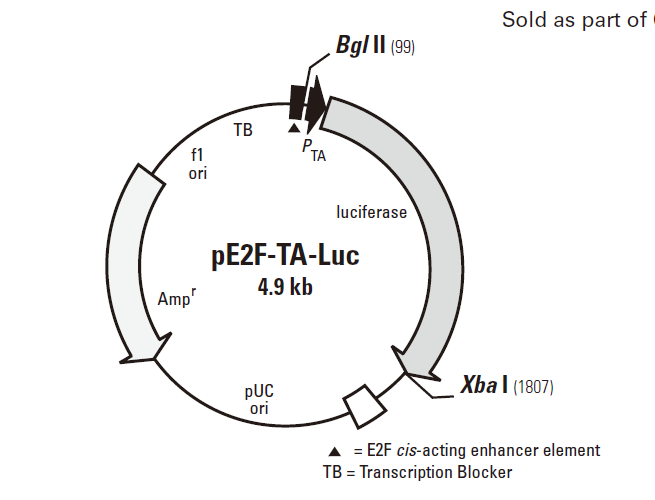pE2F-TA-Luc 载体
pE2F-TA-Luc is designed to monitor the induction of E2F-mediated signal transduction pathways. E2F, a major target of the retinoblastoma gene (Rb), is a key regulator of cell-cycle checkpoints in mammalian cells (1–2). E2F plays a critical role in stimulating expression of genes encoding growth-promoting proteins (3), and is involved in regulating the expression of important genes during cell proliferation (4–5). The E2F protein forms a heterodimer complex with the DP1 protein, which binds to E2F response elements and initiates transcription of genes necessary for DNA replication. Studies have shown that deregulation of E2F results in a loss of cell-cycle checkpoints—thereby predisposing cells to uncontrolled growth (1–5). pE2F-TA-Luc contains four copies of the E2F enhancer element (6), located upstream of the minimal TA promoter, the TATA box from the herpes simplex virus thymidine kinase promoter (PTA). Located downstream of PTA is the firefly luciferase reporter gene (luc). Upon binding of the E2F/DP1 complex to the cis-acting E2F enhancer element, transcription is induced and the reporter gene is activated.
The luciferase coding sequence is followed by the SV40 late polyadenylation signal to ensure proper, efficient processing of the luciferase transcript in eukaryotic cells. A synthetic transcription blocker (TB) is located upstream of the cis-acting enhancer element. It is composed of adjacent polyadenylation and transcription pause sites for blocking nonspecific transcription (7). The vector backbone also contains an f1 origin for single-stranded DNA production, a pUC origin of replication, and an ampicillin resistance gene for propagation and selection in E. coli.
载体应用
pE2F-TA-Luc is designed for monitoring cell-cycle signaling in mammalian cells by assaying for luciferase activity. For example, induction of E2F-mediated signal transduction pathways may be compared across different cell types or cell states by transiently transfecting this vector into appropriate cell lines. After transfection, treat each culture individually with a drug candidate or stimulus of interest, then compare the activation of the E2F response element by assaying for the luciferase reporter gene. Additionally, you can monitor pathway activation by cotransfecting this vector with an expression vector containing a gene of interest. Luciferase is a highly sensitive enzymatic reporter that can be assayed by any standard luciferase-detection method, providing quantitative data on induction levels. pE2F-TA-Luc can be transfected into mammalian cells by any standard method. For selecting stable clones, cotransfect with a vector containing an antibiotic resistance gene, such as neomycin, hygromycin, or puromycin, and selecting resistant clones.


